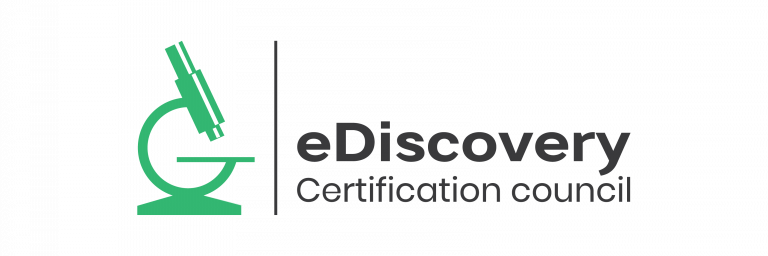eDiscovery Overview
FORMAT/STYLE
Virtual Instructor Led Training (VILT) or Instructor Led Training (ILT).
DURATION
1 day
INTENDED AUDIENCE
- eDiscovery users and archive administrators
- IT staff/Managers
- HR personnel
- Legal professionals
- Individuals responsible for internal disciplinary issues/monitoring
Prerequisite
None
REGISTRATION
Visit: www.eDiscoveryCertificateCouncil.org/List ofTrainingProviders

eDiscovery Overview
This course explains how eDiscovery interacts with the archive and where it fits in the electronic discovery reference model (EDRM). It provides instructions on where you search the archive, save your search criteria, and store and export your search results. The course shows you how to refine your search with analytics. It teaches how to create and manage person based and ad hoc legal holds. For clients that have purchased eDiscovery Analytics, this course will detail the use of Case Management, Targeted Assisted Review, and visualisation functions of search results. At the conclusion of the course you will receive reference material for future use.

Learning Objectives
- Acquire the knowledge and skills to make sure that your Users, IT Staff, and legal teams understand and can respond to the impact of increasingly eDiscovery technology.
- Learn how to respond correctly to an eDiscovery request so that you maximize the efficiency of response and minimize the costs involved
- Gain knowledge of best practice in eDiscovery
Course Outline
Lesson 1: eDiscovery Overview
This lesson provides an overview of eDiscovery and how it works. It presents where it fits in the Electronic Discovery Reference Model (EDRM) as well as its value and use by various roles.
Lesson 2: Search
This lesson teaches you how to search the Archive for selected messages and filter your search on selected criteria. It also teaches you how to save your search criteria for reuse to make additional searching more efficient.
Lesson 3: Analytics
This lesson teaches you how to run and interpret message analytics in eDiscovery.
Lesson 4: Folders
This lesson explains how to save search results in archive folders for future use, using the Folders interface.
Lesson 5: Legal Holds
This lesson teaches you how to create person-based and ad hoc legal holds. It also explains how legal holds work. You learn how to manage legal hold storage, disposition, modification, and versioning.
Lesson 6: Exporting
This lesson teaches you how to create and manage export jobs and their use. It also teaches you how to share export files.
Lesson 7: Case Management and Assisted Review
This lesson teaches the collaborative tools found within Case Management, as well as how to use Technology Assisted Review to identify responsive data within a large dataset.

